The global cruise ship market size was valued at $8 billion in 2021, and is projected to reach $16.7 billion by 2031, growing at a CAGR of 7.9% from 2022 to 2031.
A cruise ship is a luxurious passenger ship used for recreational and pleasure voyages and has all the amenities, entertainment options, activities, and attractions present only for the purpose of enhancing the passenger’s experience. It is available in various sizes, with the largest ones capable of transporting thousands of people. Cruise rides are known to be an excellent method of attracting tourist. The size and technology of a cruise ship determine its distance-traveling capabilities. Presently, cruising is a very popular aspect of the tourism industry, and most cruise ships have come to resemble floating cities.
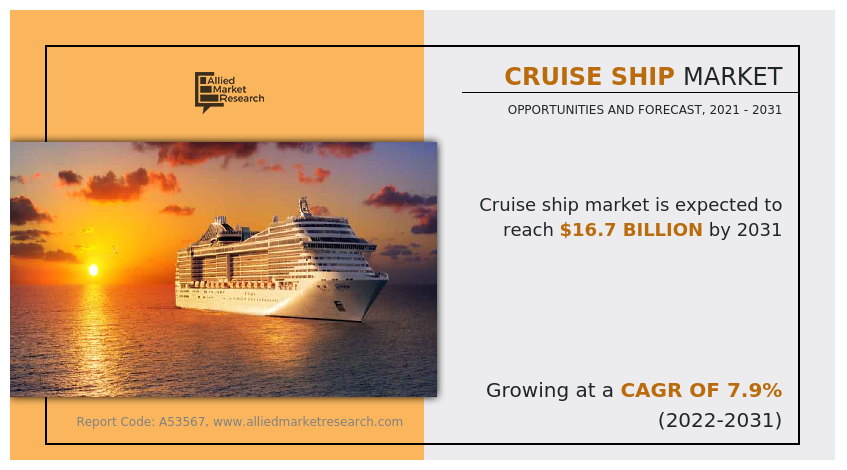
Nowadays, ships are coming with innovations and numerous exciting fun activities and theme cruises such as yoga themes, kid themes, mystery themes, and others for the travelers. Such innovations are gaining massive popularity among the targeted population, which in turn drives the growth of the cruise ship market. Also, the adoption of new technological capabilities such as artificial intelligence and machine learning augmented with different software, support the solutions offered in the market. Various cruise ship businesses that operate a fleet of small luxury cruise ships are opening to automation. For instance, in September 2019, Windstar Cruises announced to re-engine its Star-class vessels which will involve new automation and control systems, tank monitoring systems, upgraded boilers, and ballast water treatment systems. This will be sourced by Fincantieri who provides ship automation and navigation systems for Naval vessels, Cruise ships, Ferries and Yachts.
Furthermore, the cruise ship industry is experiencing an increase in spending from global players. Most of the vacationers select cruise as it offers an all-in-one experience, several entertainments, and dining options, and the availability for families to stay together while enjoying separate vacations. For instance, in October 2022, Silversea Cruises upgraded its newest ship Silver Endeavour, the world’s most luxurious expedition vessel, with four signature restaurants, as well as the cruise line’s Arts Café and 24-hour in-suite dining. The exceptional culinary offering aboard Silver Endeavour helps to discern the ship as the most luxurious expedition vessel in the world.
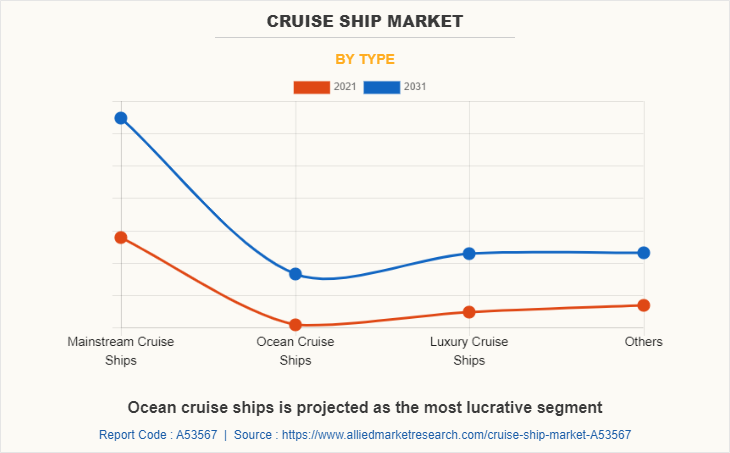
Also, digital freight forwarding services are becoming beneficial for cost-sensitive customers who seek an extensive variety of high-quality products with faster delivery timelines. Thus, an increase in trading activities due to globalization propels the demand for digital freight forwarding services, which in turn fuels the cruise ship market share. The U.S. currently has around 14 free trade agreements with 20 countries in force. UK and India are expected to sign an Early Harvest Agreement by March 2022, which permits both nations to establish selective benefits in commodities and services. Thus, all these factors are expected to increase import-export activities, which, in turn, is projected to create growth opportunities for cruise ships in the logistics industry during the forecast period.
The factors such as rise in tourism & hospitality industry, growth in marine safety norms and increase in international marine freight transport supplement the growth of the cruise ship market. However, rise in concerns regarding environmental pollution & high costs of cruises and fluctuations in transportation & inventory costs are the factors expected to hamper the growth of the market. In addition, the anticipated trend of automation in marine transportation and the growth of the digital freight forwarding industry creates market opportunities for the key players operating in the market.
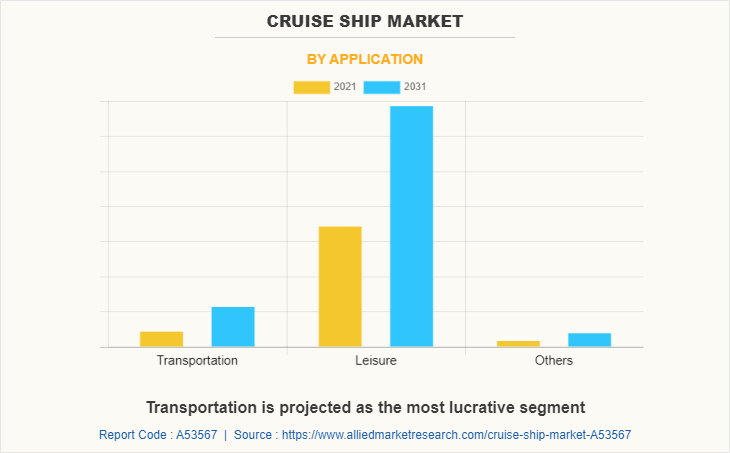
The cruise ship market is segmented on the basis of type, application, size, and region. By type, it is divided into mainstream cruise ships, ocean cruise ships, luxury cruise ships, and others. By application, it is fragmented into transportation, entertainment, and others. By size, it is categorized into small, mid, and large. By region, it is analyzed across North America, Europe, Asia-Pacific, and LAMEA.
The leading players operating in the cruise ship market are AmaWaterways, DSME Co. Ltd., Fincantieri S.P.A., Hyundai Heavy Industry Co. Ltd., Meyer Werft Gmbh & Co. Kg, Mitsubishi Heavy Industry. Ltd., MSC Cruises S.A., Norwegian Cruise Line Holdings Ltd., Samsung Heavy Industries Co. Ltd., and Silversea.
Rise in tourism & hospitality industry
The hospitality & tourism industry has grown multiple folds in the last few decades. Countries like India, Brazil, South Africa, and others have eased norms to open up investment opportunities for the largest hospitality companies in the world. Also, technological developments is one of the most significant factors in the increasing tourism & hospitality industry, which leads to the adoption of more airlines and cruises. At the beginning of 2020, ocean cruise ships were one of the fastest-growing sectors of the travel industry. Despite the COVID-19 pandemic, cruise companies are progressing on existing fleet expansion projects and restarting shipyard operations that were put on hold in 2020. For instance, in 2021, according to the Australian government, the total income of the marine industry increased substantially in the two years (by almost 28%), driven by growth in offshore natural gas production (up 79%), shipbuilding & repair (up 57%), and marine tourism (up 11%). Moreover, domestic travel, especially the leisure segment, marked the popularity of cruise ship in the tourism industry, contributing toward the market growth during the forecast period.
Increase in international marine freight transport
Marine transportation is one most prominent modes of transportation, especially for freight transportation, owing to its cost-effectiveness. In recent years, the seaborne trade has witnessed significant growth. For instance, according to the United Nations Conference on Trade and Development (UNCTAD), in 2020, international seaborne trade volume reached 10.7 billion tons. Furthermore, according to the UNCTAD organization report, in November 2021, the global trade for merchandise goods increased in exports and imports. In 2021, the import of goods increased by 13.3% globally and the export of goods increased by 14.3% globally. Moreover, according to the UNCTAD organization, international maritime trade was increasing during the past years (2010–2019); in 2010, the global maritime trade was 8,408 million tons loaded; and, in 2019, it reached 11,076 million tons. Moreover, surge in demand for maritime freight transportation has led to rise in demand for cruise line vessels. According to the UNCTAD, commercial cruise shipping fleet of 100 gross tons and above reached around 99,800. Thus, demand for maritime transport services and the growth of international maritime freight transport is expected to fuel demand for the global cruise ship market during the forecast period.
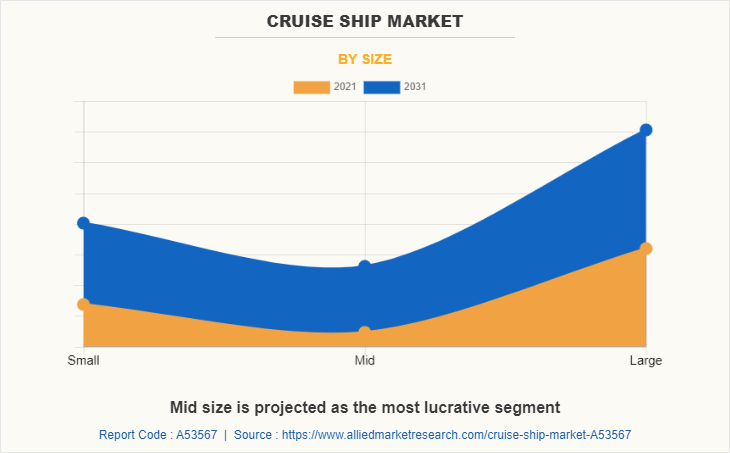
Rise in concerns regarding environmental pollution & high costs of cruises
Cruise ships, which are often hundreds of feet long and carry thousands of passengers and crew and have been compared to floating cities. The ships are a combination of hotel operations, restaurants, entertainment, bars, amusement park, and theatre all rolled into one. Meanwhile, the cost of a cruise ship depends on many factors, including size, amenities, and decor. For instance, in 2022, Carnival launched the Carnival Celebration at the cost of $1 billion. In the same year, Norwegian Prima debuted at a cost of around $850 million. Royal Caribbean's Oasis was the most expensive cruise ship ever built, which cost $1.4 billion. Cruise passengers and crews generate a significant amount of waste and pollutants. Ocean cruise ships are responsible for approximately 77.0% of marine pollution globally. Thus, the increase in awareness activities by environmental organizations and expensive costs coupled with cruises are expected to hamper the market growth.
Anticipated trend of automation in marine transportation
The steps toward automation in the field of marine, along with the demonstrations & testing of cruise ships of giant companies, have led various countries to develop automated cruise vessels. For instance, in September 2019, Windstar Cruises announced to re-engine its Star-class vessels which will involve new automation and control systems, tank monitoring systems, upgraded boilers, and ballast water treatment systems. Moreover, in July 2019, a UK cruise business, Saga Cruises of Europe, developed new Spirit-class passenger ships, which integrate navigation, automation, propulsion management and safety systems costing USD 400m. The vessel will have a safety monitoring and control system (SMCS) integrated into the ship automation and navigation systems supplied by Kongsberg Maritime. Thus, the integrated trend of marine automation systems and the vast majority of the players functioning continuous innovation in cruise ships to improve the performance in scalability and automated tracking is expected to create lucrative opportunities for the global cruise ship market.
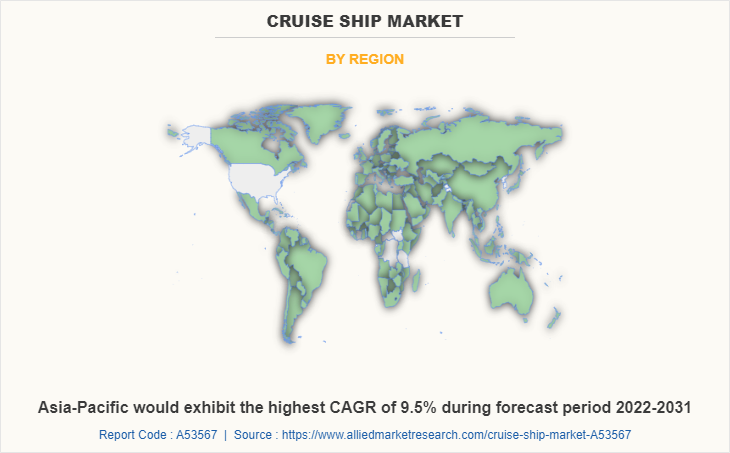
KEY BENEFITS FOR STAKEHOLDERS
- This study presents analytical depiction of the global cruise ship market analysis along with current trends and future estimations to depict imminent investment pockets.
- The overall cruise ship market opportunity is determined by understanding profitable trends to gain a stronger foothold.
- The report presents information related to the key drivers, restraints, and opportunities of the global cruise ship market with a detailed impact analysis.
- The current cruise ship market is quantitatively analyzed from 2021 to 2031 to benchmark the financial competency.
- Porter’s five forces analysis illustrates the potency of the buyers and suppliers in the industry.
Cruise Ship Market Report Highlights
| Aspects | Details |
| Market Size By 2031 | USD 16.7 billion |
| Growth Rate | CAGR of 7.9% |
| Forecast period | 2021 - 2031 |
| Report Pages | 239 |
| By Type |
|
| By Application |
|
| By Size |
|
| By Region |
|
| Key Market Players | Meyer Werft Gmbh & Co. Kg, Silversea Cruises, MSC Cruises S.A., AmaWaterways, Fincantieri S.p.A., Mitsubishi Heavy Industry. Ltd., Samsung Heavy Industries Co. Ltd., Hyundai Heavy Industry Co. Ltd., DSME Co. Ltd., Norwegian Cruise Line Holdings Ltd. |
Analyst Review
Increase in leisure trips and voyages with the surge in preference of a high population to live a luxury life, is contributing toward the market growth. The rise in popularity of the river cruises is likely to drive the growth of the cruise ship market. River cruises offer attractive packages that allow for travel inside the countries and not just the coastal areas. These types of river cruises are gaining popularity in the European countries. For instance, in August 2022, AmaWaterways launched its award-winning luxury river cruise line AmaLucia, with a festive ceremony in Rüdesheim, Germany. This ship offered comfortable affair lined with 180 degrees of floor-to-ceiling windows that offer river views and private balconies.
Also, marine transportation is one of the most prominent modes of transportation, especially for freight transportation, owing to its cost-effectiveness. Thus, it has always been recognized that the best way of improving safety at sea is by developing international regulations. The cruise industry is one of the most heavily regulated industries with robust, clearly defined standards. The average ship undergoes dozens of announced and unannounced safety inspections per year, involving hundreds of man-hours and the implementation of thousands of specific requirements set by the International Maritime Organization (IMO) and other authorities. This includes various treaties dealing with cruise ships safety for its design and construction, Navigation Communications Search and Rescue (NCSR), ship system equipment, and pollution prevention and response. Such implementation of treaties regarding marine safety are expected to drive the growth of the cruise ship market in the near future.
In addition, leading market players of cruise ship industry offer services in the ocean cruises for intercontinental trips such as exciting tour packages, amenities, and entertainment activities which boost the market revenue share. In addition, a large customer base prefers ocean cruises over other cruises as it provides spacious areas as compared to the others. For instance, in December 2022, MSC Cruises S.A. launched MSC Seascape to its fleet of innovative and glamourous ships. The ship features 2,270 cabins with 12 different types of staterooms & suites,11 dining venues, 19 bars & lounges, six swimming pools, including a stunning aft infinity pool, an expansive waterfront promenade, and a spectacular bridge of sighs on deck 16 with a breath-taking view of the ocean.
Among the analyzed regions, North America is the highest revenue contributor, followed by Europe, LAMEA, and Asia-Pacific. On the basis of forecast analysis, Asia-Pacific is expected to lead during the forecast period, due to cheaper wages, strong government backing, and strong forward & backward linkage industries. In addition, surge in disposable incomes is expected to drive the demand for imports of commodities and finished goods, which is projected to supplement seaborne trade in emerging economies, in turn, propelling the growth of the market
The cruise ship market is estimated to reach $16,694.20 million by 2031, exhibiting a CAGR of 7.9% from 2022 to 2031.
AmaWaterways, DSME Co. Ltd., Fincantieri S.P.A., Hyundai Heavy Industry Co. Ltd., Meyer Werft Gmbh & Co. Kg, Mitsubishi Heavy Industry. Ltd., MSC Cruises S.A., Norwegian Cruise Line Holdings Ltd., Samsung Heavy Industries Co. Ltd., and Silversea are the top companies to hold the market share in cruise ship.
The luxury cruise ship is the leading application of cruise ship market owing to the growing trend of usage of small luxury yachts and small-ship cruises for luxury tourism.
Rise in tourism & hospitality industry, anticipated trend of automation in marine transportation and the growth of the digital freight forwarding industry are the upcoming trends of cruise ship market in the world.
North America is the largest regional market for cruise ship.
Loading Table Of Content...


